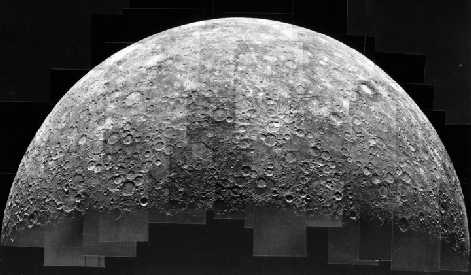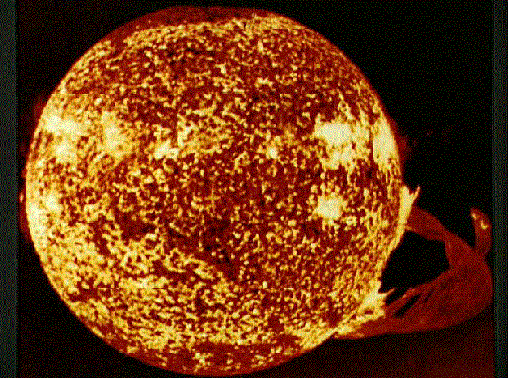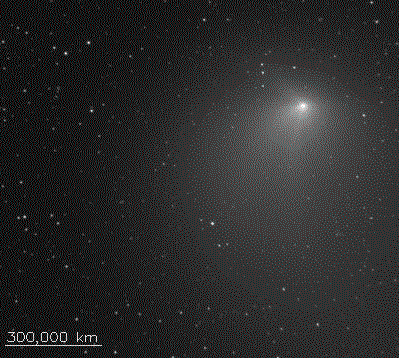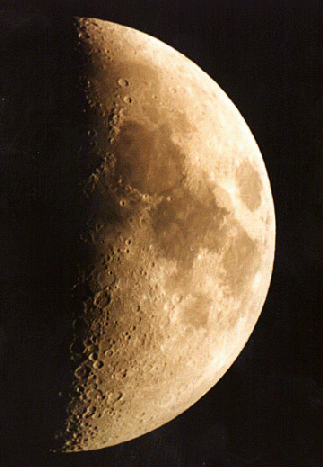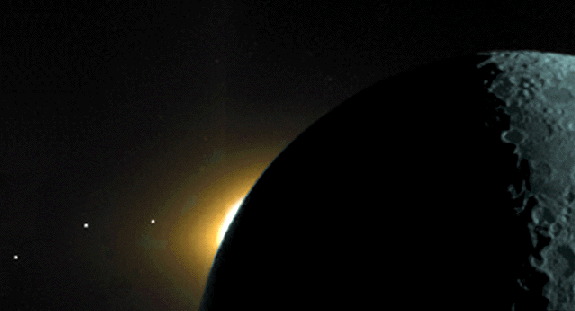NASA APOD #451-460
#451 Tomorrow's picture: September 12, 1996
“ Mercury's surface looks similar to our Moon's. Each is heavily cratered and made of rock. Mercury's diameter is about 4800 km, while the Moon's is slightly less at about 3500 km (compared with about 12,700 km for the Earth). But Mercury is unique in many ways. Mercury is the closest planet to the Sun, orbiting at about 1/3 the radius of the Earth's orbit. As Mercury slowly rotates, its surface temperature varies from an unbearably cold -180 degrees Celsius to an unbearably hot 400 degrees Celsius. The place nearest the Sun in Mercury's orbit changes slightly each orbit - a fact used by Albert Einstein to help verify the correctness of his then newly discovered theory of gravity: General Relativity. The above picture was taken by the only spacecraft ever to pass Mercury: Mariner 10 in 1974. "
Copyright: Public domain
#452 Tomorrow's picture: September 13, 1996
“ The planet Mercury resembles a moon. Mercury's old surface is heavily cratered like many moons. Mercury is larger than most moons but smaller than Jupiter's moon Ganymede and Saturn's moon Titan. Mercury is much denser and more massive than any moon, though, because it is made mostly of iron. In fact, the Earth is the only planet more dense. A visitor to Mercury's surface would see some strange sights. Because Mercuryrotates exactly three times every two orbits around the Sun, and because Mercury's orbit is so elliptical, a visitor to Mercury might see the Sun rise, stop in the sky, go back toward the rising horizon, stop again, and then set quickly over the other horizon. From Earth, Mercury's proximity to the Sun cause it to be visible only for a short time just after sunset or just before sunrise. "
Copyright: Public domain
#453 Tomorrow's picture: September 14, 1996
“ Here lived one of the greatest thinkers in human history. Aristarchus lived on the Greek island of Samos, a small island in the center of the above picture that can be identified with a good map. Aristarchus, who lived from 310 BC to 230 BC, postulated that the planets orbited the Sun - not the Earth -- over a thousand years before Copernicus and Galileo made similar arguments. Aristarchus used clear logic to estimate the size of the Earth, the size and distance to our Moon, the size and distance to our Sun, the the even deduced that the points of light we see at night are not dots painted on some celestial sphere but stars like our Sun at enormous distances. Aristarchus' discoveries remained truly unbelievable to the people of his time but stand today as pillars of deductive reasoning. "
Copyright: Public domain
#454 Tomorrow's picture: September 15, 1996
“ Tycho Brahe was the most meticulous astronomical observer of his time. Brahe, who lived between 1546 and 1601, set out to solve the day's most pressing astronomical problem: to determine whether the Earth or the Sun was at the center of the Solar System. To do this he and his assistants created the first major astronomical observatory where they devised and used the most accurate pre-telescopic astronomical instuments. Tycho Brahe thus compiled tables of precise measurements of the positions and brightnesses of planets and stars. Brahe never solved the Solar System problem himself - but left data so impressively accurate his assistant Johannes Kepler was able to develop definitive laws. Brahe is also remembered for witnessing a supernova in 1572, showing that the Great Comet of 1577 was not an atmospheric phenomena, and for his metal nose. "
Copyright: Public domain
#455 The Sun Erupts September 16, 1996
“The Sun is a seething ball of extremely hot gas. Above, the Sun was captured by Skylab in 1973 throwing off one the largest eruptive prominences in recorded history. The Sun has survived for about 5 billion years, and will likely survive for another 5 billion. The Sun is not on fire, will never explode, and a solar flare will never destroy the Earth. The Sun continues to present many unanswered questions. For example: Why is the Sun's corona so hot? What causes the Sun's unusual magnetic field? Why does the Sun's center emit so few neutrinos? "
Copyright: Public domain
#456 Tomorrow's picture: September 17, 1996
“ Comet Hale-Bopp has faded in the past few weeks. For Hale-Bopp, promised as the Great Comet of 1997, this was a bit of a disappointment -- but not entirely unexpected. Comet Hale-Bopp continues to approach the Sun - making the comet itself brighten, but now the Earth is moving away from it - making the comet appear to dim. Experts disagree on just how bright Hale-Bopp will become. Optimists hope it will eventually outshine Comet Hyakutake, but some pessimists now expect no better than 3rd magnitude - hardly visible from well-lit cities. Comet Hale-Bopp still appears to be, however, a very large comet, and is sure to show much activity as it nears the Sun. The comet should reach peak brightness in March 1997. This image was taken on August 18th and shows gas shed from the nucleus of the comet."
Copyright: Public domain
#457 Tomorrow's picture: September 18, 1996
“What if you could see infrared light? Because this light is less absorbed by dust than visible light, you could peer into the center of our Milky Way Galaxy. The stars there are normally hidden from direct view by the interstellar dust clouds which line the Galactic plane. Above is a false color image of the entire sky made by the DIRBE instrument onboard NASA's COBE Satellite using infrared light with a wavelength of 3.5 microns - about 7 times longer than the wavelength of visible light. The galactic plane runs horizontally along the middle of the image. At this wavelength, the cool stars in our galaxy shine brightly and can be seen to define the plane of the Milky Way and the central bulge. Interplanetary dust, which tends to lie along the plane of our own solar system, scatters sunlight and emits radiation at these wavelengths too. The faint glow it produces results in the "S" shape apparent in this infrared all-sky view."
Copyright: Public domain
#458 Information: September 19, 1996
“A clear blue summer sky finally grows dark and the new telescope, hastily set up in the backyard, generates excitment and anticipation. "I bought it for the kids ...", Dad assures himself as he over-anxiously supervises the two young boys' efforts to center a bright, first quarter Moon, in the finder. The evening's first target acquired, James adjusts the focus knob and falls silent. Suddenly, "Wow, looks just like on Apollo 13!". His younger brother Christopher takes his turn. "Do you see the Moon?", James asks, eager to provide guidance based on his own observing experience. Christopher echoes his brother's enthusiasm, "Yes, and I see all the crashes too!". The view they shared was not too different from the above image of a six day old moon, recorded in July 1995 by Rhode Island amateur astronomer Jim Hendrickson. Along the terminator, the line between lunar night and day, the shadows outline to advantage the spectacular craters -- caused by all the crashes. Information: Thursday, September 26 - A Total Lunar Eclipse"
Copyright: J. Hendrickson
#459 Tomorrow's picture: September 20, 1996
“ Two weeks ago Hurricane Fran, pictured above, struck the east coast of the United States. Hurricanes are huge swirling storms with cloud systems typically larger than a state. Tropical cyclones, called Hurricanes in Earth's Western Hemisphere and Typhoons in the Eastern Hemisphere, get their immense energy from warm evaporated ocean water. As this water vapor cools and condenses, it heats the air, lowers pressure and hence causes cooler air to come swooshing in. Winds can reach over 150 miles per hour and become very dangerous. Hurricane Fran, for example, killed more than 30 people and destroyed many million of dollars worth of property. Much remains unknown about cyclones, including how they are formed and the exact path they will take."
Copyright: Public domain
#460 Information: September 21, 1996
“The Plane of the Ecliptic is illustrated in this Clementine star tracker camera image which reveals (from right to left) the Moon lit by Earthshine, the Sun's corona rising over the Moon's dark limb, and the planets Saturn, Mars, and Mercury. The ecliptic plane is defined as the imaginary plane containing the Earth's orbit around the Sun. In the course of a year, the Sun's apparent path through the sky lies in this plane. The planetary bodies of our solar system all tend to lie near this plane, since they were formed from the Sun's spinning, flattened, proto-planetary disk. The snapshot above nicely captures a momentary line-up looking out along this fundamental plane of our solar system. Information: Thursday, September 26 - A Total Lunar Eclipse"
Copyright: Public domain
Upvote! Resteem! Comment! As you like it! Thank you for attention!
